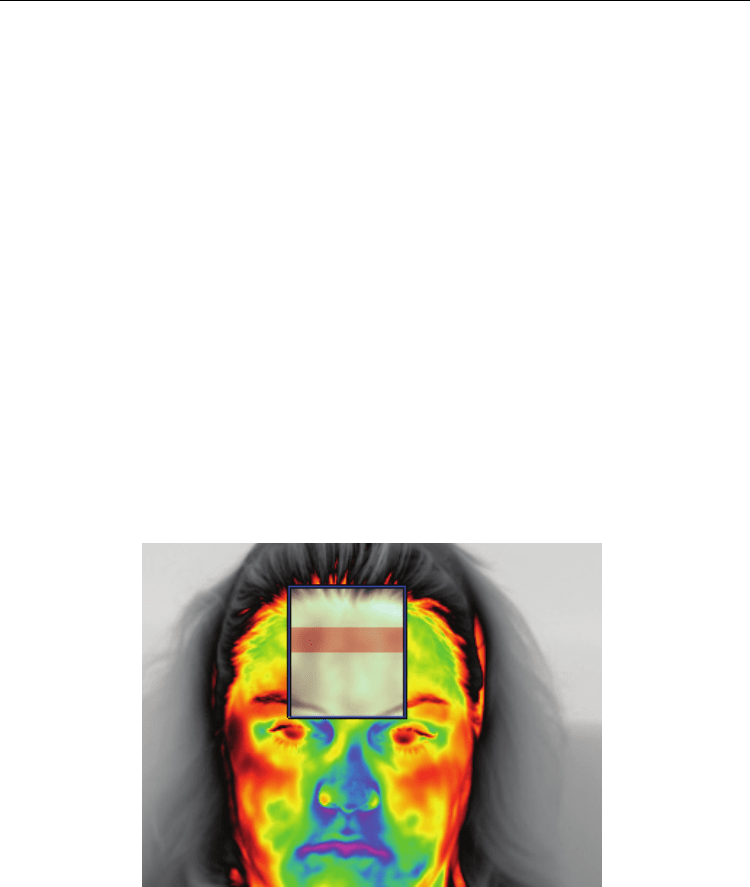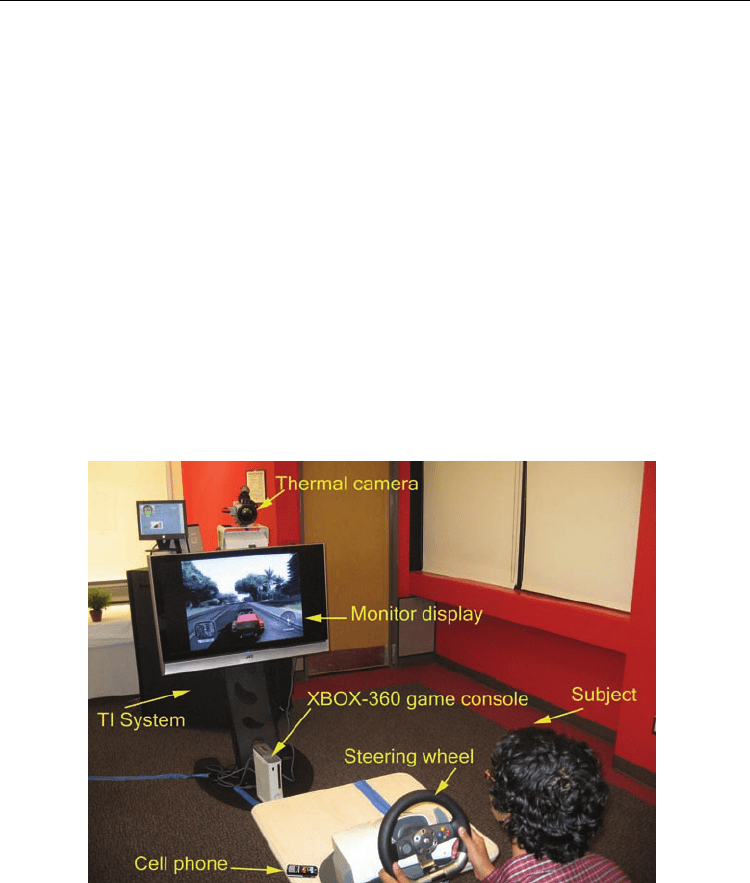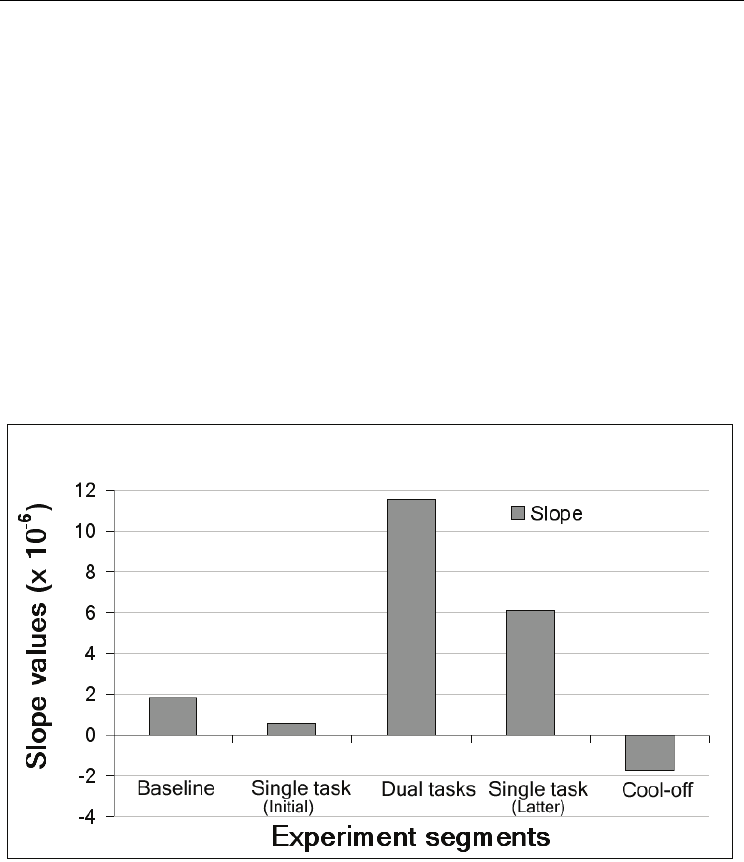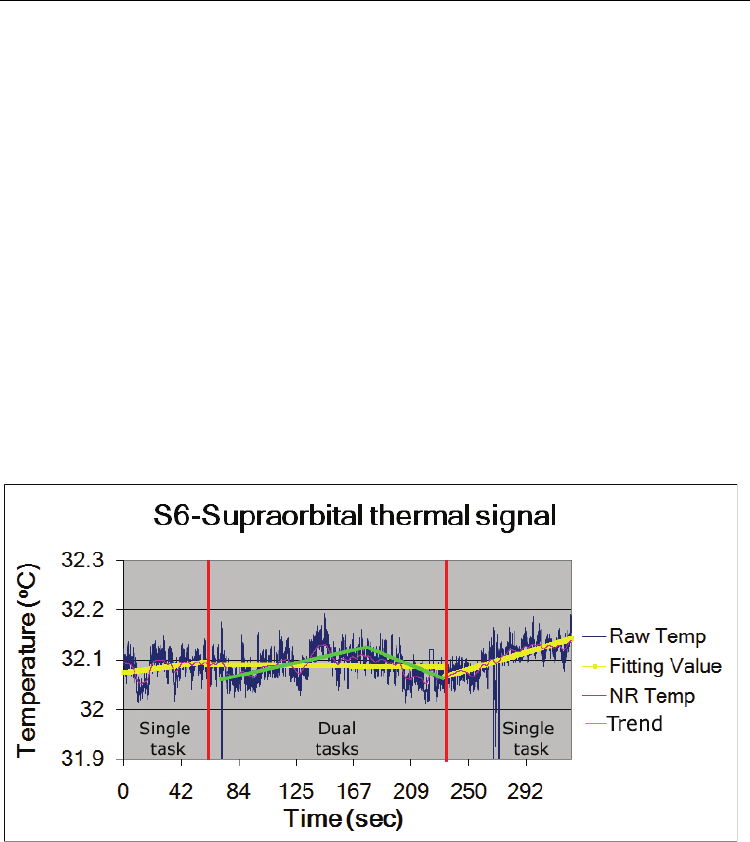Pavlidis I. (ed.) Human-Computer Interaction
Подождите немного. Документ загружается.


Visual Information Presentation in Continuous Control Systems using Visual Enhancements
123
As previous results have mentioned, the results of ANOVA showed that the performance
and subjective workload were significantly affected by the types of visual enhancements
and task difficulties. Also, the results of a pair-wise analysis showed that the amount of
deviation between the mouse pointer and the horizontal bar moving on an indicator were
reduced by tendering visual enhancement cues. Particularly, the performance and subjective
ratings were significantly improved in the case of providing a shaded reference bar (Shade)
and a translucent reference bar (Shade with line). From the results of comparing the means
for each level of the task difficulty, as the task difficulty increased, the degree of a deviation
between the mouse pointer and the moving horizontal bar of the indicator were gradually
increased. The low velocity (LOW) of a task difficulty was significantly different from the
medium velocity (Medium) and high velocity (High). This results support previous findings
that virtual cues can be utilized to provide additional visual information for the tasks
requiring considerable attention such as a tracking task (Hardy & Lewis, 2004; Park & Koo,
2004).
5. Conclusion
This chapter was intended to identify and quantify the effects of visual enhancement cues
on the performance of continuous control tasks such as tracking tasks. Also, we investigated
the types and utilities of visual enhancements as visual aids that improve a performance and
offer spatial information. Especially, we have indentified that various visual enhancements
improve not only a performance but also the possibility of an error through a case study.
The findings of this chapter are applicable to the design of a head-mounted display (HUD)
in the context of virtual environments. These findings can also be used as guidelines for
designing visual displays for a continuous control system accompanied with a high speed
manipulation such as those found in automobile and aircraft systems. Especially, the results
of this case study could be applied to design the guidance for the information representation
in an information system based HUD such as a Smart car which is an IVIS (In Vehicle
Information System) developed by GM motors and Carnegie Mellon University.
In this chapter, when the continuous control tasks were performed through visual
enhancements, it was assumed that the participants received visual cues from the same
point of view. However, it didn’t consider factors such as a depth perception and a pattern
recognition of the subjects who were the main recipients of the visual information. Further
studies are needed with considerations on the cognitive properties.
6. References
Andre, A.D., Wickens, C.D., Moorman, L. & Boschelli, M.M. (1991). Display Formatting
Techniques for Improving Situation Awareness in the Aircraft Cockpit. International
Journal of Aviation Psychology, Vol. 1, No. 3, pp. 205-218, ISSN: 1050-8414
Aretz, A.J. (1991). The design of electronic map displays. Human Factors, Vol. 33, No. 1, pp.
85-101,
ISSN: 0018-7208
Barfield, W., Rosenberg, C., Han, S.H. & Furness, T. (1992). A God’s eye (exocentric) versus
pilot’s eye (egocentric) frame-of-reference for enhanced situation awareness. Interactive
Computer Graphics and Human Factors Laboratory, University of Washington,
Seattle, WA

Human-Computer Interaction
124
Barfield, W., Rosenberg, C. & Furness III, T.A. (1995). Situation Awareness as a Function of
Frame of Reference, Computer-Graphics Eyepoint Elevation, and Geometric Field
of View. International Journal of Aviation Psychology, Vol. 5, No. 3, pp. 233-256, ISSN:
1050-8414
Baty, D.L., Wempe, T.E. & Huff, E.M. (1974). A study of aircraft map display location and
orientation. IEEE Transactions on Systems, Man, and Cybernetics, Vol. 4, No. 6, pp.
560-568, ISSN: 0018-9472
Boff, K.R., Kaufman, L. & Thomas, J. (1986). Handbook of Perception and Human Performance:
Sensory Processes and Perception, Cognitive Processes and Performance. John Wiley &
Sons, ISBN: 0471829560, New York
Dingus, T.A., Antin, J.F., Hulse, M.C. & Wierwille, W.W. (1989). Attentional Demand
Requirements of an Automobile Moving-Map Navigation System, Transportation
Research Part A: General, Vol. 23, No. 4, pp. 301-315, ISSN: 0191-2607
Dul, Jan & Weerdmeester, B.A. (2001). Ergonomics for Beginners: A Quick Reference Guide, (2
nd
Ed.), Taylor & Francis, ISBN: 0748408258, London
Ellis, S.R., Tyler, M., Kim, W.S., McGreevy, M.W. & Stark, L. (1985). Visual enhancements for
perspective displays: perspective parameters. Proceedings of the International
Conference on Systems Man and Cybernetics, pp. 815-818, Tucson, Arizona, November,
1985, Institute of Electrical and Electronics Engineers, New York
Evans, L. (1997). A Crash Course in Traffic Safety. In: 1997 Medical and Health Annual, E.
Bernstein, pp. 126-139, Encyelopedia Britannica, ISBN: 0852296320, Chicago
Hardy, G.H. & Lewis, E.K. (2004). Cockpit Display of Traffic and Wake Information for
Closely Spaced Parallel Approaches. Proceedings of AIAA Guidance, Navigation, and
Control Conference and Exhibit, AIAA-2004-5106, Providence, RI
Harwood, K. & Wickens, C.D. (1991). Frames of Reference for Helicopter Electronic Maps:
The Relevance of Spatial Cognition and Componential Analysis. International
Journal of Aviation Psychology, Vol. 1, No. 1, pp. 5-23, ISSN: 1050-8414
Korea Transport Institute. (2006). 2003 Traffic Accident Estimate Costs in Korea. Korea
Transport Institute
Lee, J.S. (1998). The Human Factors Considerations on Design of In-Vehicle Navigation
System, '98 Pusan kyungnam Automotive Techno Center Workshop, Pusan kyungnam
Automotive Techno Center, Busan, February, 1998
McGreevy, M.W. & Ellis, S.R. (1985). A perspective format for cockpit traffic displays. Tech.
Report (Tech. Report NASA-TP85126), NASA Ames Research Center, Aerospace
Human Factors Research Division, Moffett Field, California
McGreevy, M.W. & Ellis, S.R. (1991). Format and basic geometry of a perspective. display of air
traffic for the cockpit (Tech. Memorandum 86680), NASA Ames Research Center,
Aerospace Human Factors Research Division, Moffett Field, California
Meehan, J.W. & Triggs, T.J. (1988). Magnification effects with imaging displays depend on
scene content and viewing condition. Human Factors, Vol. 30, No. 4, pp. 487-494,
ISSN: 0018-7208
Meehan, J.W. (1992). Imaging-display micropsia, experience, and ocular dominance. In
Society for Information Display International Symposium Digest of Technical Papers, Vol.
23, pp. 301-303, ISSN: 0003-966X
Ministry of Construction & Transportation. (2005). 2005 Transportation safety enforcement plan.
Ministry of Construction & Transportation

Visual Information Presentation in Continuous Control Systems using Visual Enhancements
125
Olmos, O., Liang, C.C. & Wickens, C.D. (1997). Electronic Map Evaluation in Simulated
Visual Meteorological Conditions. International Journal of Aviation Psychology, Vol. 7,
No. 1, pp. 37-66, ISSN: 1050-8414
Park, S.H. & Koo, J.M. (2004). Effects of Tele-Robotic Task Characteristics on the Choice of
Visual Display Dimensionality. Journal of the Ergonomics Society of Korea, Vol. 23, No.
2, pp. 25-35, ISSN: 1229-1684
Park, S.H. & Woldstad, J.C. (2006). Design of visual displays for teleoperation, In:
International Encyclopedia of Ergonomics and Human Factors, W. Karwowski, (2
nd
Ed.),
pp. 1579-1583, Taylor & Francis, ISBN: 041530430X, London
Poulton, E.C. (1974). Tracking skill and manual control, Academic Press, ISBN: 0125635508,
New York
Rate, C. & Wickens, C.D. (1993). Map dimensionality and frame of reference for terminal area
navigation displays: Where do we go from here? (Tech. Report No. ARL-93-5/NASA-93-1),
Institute of Aviation, Aviation Research Laboratory, University of Illinois, Savoy
Roscoe, S.N., Corl, L. & Jensen, R.S. (1981). Flight display dynamics revisited. Human Factors,
Vol. 23, No. 3, pp. 341-353, ISSN: 0018-7208
Sanders, M.M. & McCormick, E.J. (1993). Human Factors in Engineering & Design, 7th ed.,
McGraw-Hill, ISBN: 007054901X, New York
Sivak M. (1996), The information that drivers use: is it indeed 90% visual?. Perception Vol. 25,
No. 9, pp. 1081–1089, ISSN: 0301-0066
Wickens, C.D. (1986). The effects of control dynamics on performance. In: Handbook of
perception and performance, K. Boff, L. Kaufman, & J. Thomas(Eds.), Vol. II, pp. 39-1-
39-60, John Wiley & Sons, ISBN: 0471829560, New York
Wickens, C.D., Haskell, I., & Harte, K. (1989a). Ergonomic design for perspective flightpath
displays. IEEE Control Systems Magazine, Vol. 9, No. 4, pp. 3-8, ISSN: 0272-1708
Wickens, C.D., Todd, S. & Seidler, K. (1989b). Three-dimensional displays: perception,
implementation and applications (Tech. Report No. CSERIAC SOAR 89-001), Crew
System Ergonomics Information Analysis Center
Wickens, C.D., Liang, C.C., Prevett, T. & Olmos, O. (1994). Egocentric and exocentric displays
for terminal area navigation (Tech. Report No. ARL-94-1/NASA-94-1), Institute of
Aviation, Aviation Research Lab, University of Illinois, Savoy
Wickens, C.D. & Prevett, T. (1995). Exploring the dimensions of egocentricity in aircraft
navigation displays: influences on local guidance and global situation awareness.
Journal of Experimental Psychology: Applied, Vol. 1, No. 2, pp. 110-135, ISSN: 1076-
898X
Wickens, C.D., Liang, C.C., Prevett, T., & Olmos, O. (1996). Electronic maps for terminal area
navigation: effects of frame of reference and dimensionality. International Journal of
Aviation Psychology, Vol. 6, No. 3, pp. 241-247, ISSN: 1050-8414
Wickens, C.D., & Hollands. J.G. (2000). Engineering Psychology and Human Performance. 3rd ed.,
Prentice-Hall, ISBN: 0321047117, Upper Saddle River, NJ
Wickens, C.D., Lee, J.D., Liu, Y. & Gordon, S.E. (2003). An Introduction to Human Factors
Engineering, (2nd Ed.), Prentice Hall. ISBN: 0131837362, Newark, NJ
Wierwille, W.W. & Casali, J.G. (1983). A Validated Rating Scale for Global Mental Workload
Measurement Applications. Proceedings of the Human Factors Society 27th Annual
Meeting, pp. 129–133, Norkfolk, October, 1983, Human Factors and Ergonomics
Society, Santa Monica, California

Human-Computer Interaction
126
Woods, D.D. (1984). Visual Momentum: A concept to improve the cognitive coupling of
person and computer. International Journal of Man-Machine Studies, Vol. 21, pp. 229-
244, ISSN: 0020-7373
9
Contact-free Stress Monitoring for User’s
Divided Attention
Dvijesh Shastri, Avinash Wesley, Ioannis Pavlidis
Computational Physiology Lab, Department of Computer Science, University of Houston,
USA
1. Introduction
During many occasions, computer users and machine users in general have to perform more
than one task simultaneously. When a combination of events demands critical decisions and
rapid actions, the subject’s alertness is raised. If alertness persists, it is likely to reach beyond
certain acceptable levels and ultimately transform into stress. Stress due to the subject’s
divided attention may lead to degradation of his/her performance for one or more
simultaneous tasks.
In this study, we describe research that aims to quantify stress levels of subjects due to
divided attention. Such cases often arise in software use and beyond and take a serious toll
on performance and emotion. The proposed method is based on the thermal signature of the
face. We use the supraorbital skin temperature as the physiological variable of interest.
Because of higher measurement sensitivity and its contact-free nature, facial thermal stress
monitoring has been an increasingly popular approach (Puri et al., 2005, a. Pavlidis et al.,
2002, b. Pavlidis et al., 2002). Contact sensor based physiological measurement methods
restrict subjects’ motion and increase their awareness of being monitored (Yamaguchi et al.
2006, Yamakoshi et al. 2007, Healey et al 2005). Therefore, it is not a very effective way for
continuous physiological monitoring.
Although concurrent execution of multiple tasks is part of human life, no sufficient research
has been done to understand its effects on human emotional states and performance. The
purpose of this study is to evaluate a subject’s emotional states and effect on performance
while executing parallel tasks. We use simulated driving and concomitant cell phone
conversation in our experimental design. This is a quintessential divided attention example
in man-machine interaction with which most people are familiar with.
The results of our research show that the simultaneous performance of dual tasks increases
blood flow in the supraorbital vessels and frontalis muscle. A change in blood flow alters
heat dissipation from the supraorbital region and thus, it can be monitored through a
thermal camera. This work opens a new area of research in non-contact stress monitoring
for divided attention situations.

Human-Computer Interaction
128
2. Methodology
During concurrent dual tasks performance, we have observed considerable skin
temperature increase in the supraorbital region of all 11 subjects. This elevated temperature
is the results of increased blood flow to the supraorbital region in order to supply energy for
the increased mental activities. This finding matches our previous reporting that user stress
is correlated with the increased blood flow in the frontal vessel of the supraorbital region
(Puri et al., 2005). In the past, we used the periorbital region to quantify stress during startle
response and polygraph examination (a. Pavlidis et al., 2002, b. Pavlidis et al., 2002,
Tsiamyrtzis et al. 2006). As oppose to our requirement, that is to monitor sustained stress
during the divided attention situations, the periorbital region is used to quantify
instantaneous stress. Moreover, the users’ continuous moving eyes during simulated
driving prevent us from using the periorbital measurement in this study. As a result, we
focus our attention to the skin temperature of the supraorbital region and its involvement in
determining sustained stress.
Unlike the periorbital area, which accommodates a wide range of temperature values, the
supraorbital area is plateau in nature. When tracks this plateau region, thin ranged feature
points of the tracker compromise its stability to a certain degree (Dowdall et. al 2007). As a
consequence, the tracker is shifted from its target position repeatedly. Therefore, we select a
larger region of interest for the tracking algorithm but compute the mean thermal footprint
of an appropriate subset of the region (Pogreška! Izvor reference nije pronađen.).
Fig. 1. The supraorbital signal was extracted from the mean thermal footprint of the pink
colored region inside the rectangle.
For every subject, we select a Region of Interest (ROI) that covers the supraorbital area (see
Figure 1). We compute the mean temperature of the ROI for every frame in the thermal clip.
We, thus, produce a 1D supraorbital temperature signal from the 2D thermal data. However,
due to imperfections in the tissue tracking and systemic noise, the measurement from this
area carries substantial noise, which we suppress to a large degree by a Fast Fourier

Contact-free Stress Monitoring for User’s Divided Attention
129
Transformation (FFT) based noise cleaning approach (Tsiamyrtzis et al. 2006). Finally, we
model the global trend of the noise-cleaned signal by fitting a linear polynomial to each
experimental segment. Figure 2 illustrates the raw temperature signal, the noise cleaned
signal, and the linear segment fitting. The slope value describes the temperature evolution of
each segment.
Fig. 2. The supraorbital raw temperature signal (marked in blue color), noise reduced (NR)
temperature signal (marked in pink color) and linear fitting (marked in yellow color). Slope
values of the respective segments are showed in blue colored text.
3. Experimental Design
We used a high quality Thermal Imaging (TI) system for the data collection. The centerpiece
of the TI system is a ThermoVision SC6000 Mid-Wave Infrared (MWIR) camera (FLIR
Systems) (NEDT=$0.025
o
C). For each subject, we recorded 3 thermal clips: while the subject
resting, playing the driving simulation game, and the cooling off period. Thus, we collected
11 subjects x 3 clips/subject = 33 thermal clips.
The data set features subjects of both genders, different races, and with varying physical
characteristics. The subjects were placed 6 feet away from the thermal camera (Fig. 3). We
used a XBOX-360 game console and the Test Drive: Unlimited game to simulate real life
driving. The subjects were asked to follow all traffic signs, drive normally and not to race
during the experiment. They were given an opportunity to test drive before the experiment
begun to facilitate themselves with the simulated driving setup. After the test drive, the
subjects were asked to relax for 5 minutes before the experiments begun. This helps to
isolate effects of other stress factors that the subjects may have carried from the past events.
The subjects’ facial thermal signature was recorded during this relaxation period. We called
it baseline segment.

Human-Computer Interaction
130
Next, the subjects were asked to play the driving simulation game. This part of the
experiment lasted for approximately 5 minutes. After around a minute of the simulated
driving (the initial single task segment), we made a cell phone call to the subjects and played
a set of prerecorded questions in the following order:
Instruction: Please do not hang up until you are told so.
Q1: Are the lights ON in the room, yes or no?
Q2: Are you a male or female?
Q3: Who won the American civil war, the north or the south?
Q4: What is 11 + 21?
Q5: How many letter ‘e’ are in the word experiment?
Q6: I am the son of a mom whose mother in law's son hit. How am I related to the other son?
Q7: My grandma's son hit his son. How are the sons related?
Q8: A man is injured in 1958 and died in 1956. How is that possible?
Q9: What is 27 + 14?
Instruction: You may now hang up the phone and pay attention to the game.
Fig. 3. Experimental setup; subject, imaging equipment, xBOX-360.
The question set was a combination of basic, logical, simple math and ambiguous questions.
The order of the questions was designed to build-up emotional pressure on the subjects.
Additional pressure was achieved by repeating one more time every question that was
incorrectly answered. The subjects were supposed to drive while talking on the cell phone
(the dual task segment). At the end of the phone conversation, subjects put the phone down
and continued driving till the end of the experiment (the latter single task segment).

Contact-free Stress Monitoring for User’s Divided Attention
131
Finally, the subjects relaxed for 5 minutes. The purpose of this so-called cool-off segment was
to monitor physiological changes after the simulated driving experiment.
4. Experimental Results
We used the slope as the thermal stress indicator. For each subject, we compute the slope
value for every experimental segment as described in the Methodology section. Fig. 4
shows the mean slope values of the various segments for the entire data set (mean subject).
The graph clearly indicates that the temperature increase during the concurrent dual tasks is
the highest among all segments. Since the temperature increase is correlated to blood flow,
the results indicate that more blood flows to the supraorbital region during the dual task
action. With the exception of subject-6 (S6), the dual task segment of all subjects has a higher
temperature gradient than its corresponding baseline and initial single task. This validates
our assumption that the user’s divided attention while critical tasks performance increases
the user’s stress level.
Fig. 4. Mean slope value of the experimental segments. The temperature increase is the
highest during the dual tasks performance.
While performing the single task second time (Latter), most of the subjects carried the
mental stress from the past dual tasks period. On the other hand, as the ablove graph
illustrates, the subjects experienced less mental stress for the same single task performed
first time (initial) as it was conducted right after the relaxation period (baseline) where they
got an opportunity to isolate their mental stress due to the past events. Most of the subjects
admitted during the post-debriefing session that they were thinking about their dual tasks

Human-Computer Interaction
132
performance while performing the latter single task. Therefore, the subjects experienced
higher mental stress during the latter single task as compared to the initial single task.
Figure 4 confirms this finding, mathematically. It illustrates that the rate of temperature
change of the latter single task is higher than that of the initial single task.
The rationale behind higher slope value of the baseline segment as compare to the initial
single task segment is that many subjects played the driving simulation game first time ever
during the test drive. Thus, the baseline segment reflects the stress level they acquired
during the test drive period, which was right before the baseline segment. The test drive
helped isolating anxiety of performing a task that was never performed before. Therefore,
the initial single task represents stress due to conducting the single challenging task only,
i.e. driving the simulated car.
S6 is an interesting subject. The supraorbital temperature of the subject increased almost half
of the dual task period and then decreased during the remaining period (Figure 5). We
found the temperature decrease on the supraorbital was due to emotional perspiration. The
cause for the emotional perspiration during divided attention is unknown to us at this point
of our research. More experiments are required to reveal the full picture and currently we
are pursuing it.
Fig. 5. During the dual task period, the supraorbital temperature (marked in blue color) of
S6 shows ascending global trend in the first half and then descending global trend in the
second half of the period as marked in green color. Therefore, the linear fitting to the
segment is approximately a horizontal line.
In all cases, the rate of temperature change of the cool-off segment is much slower than that
of the dual task segment. In most cases, the rate of the temperature change of the cool-off
segment is slower than that of the initial single task, and the latter single segments. This
illustrates that the subjects indeed felt relaxed after 5 minutes of intense mental activity.
